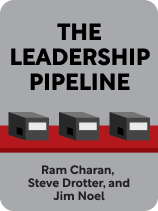

This article is an excerpt from the Shortform book guide to "The Leadership Pipeline" by Ram Charan, Steve Drotter, and Jim Noel. Shortform has the world's best summaries and analyses of books you should be reading.
Like this article? Sign up for a free trial here.
What is a leadership pipeline? What does the ideal leader look like?
The Leadership Pipeline runs through six different levels of management necessary to run any large organization. Additionally, it provides the skills required for each so employees are prepared for their next promotion.
Read below for a brief The Leadership Pipeline book overview.
The Leadership Pipeline
When it comes to training the next generation of leaders, most organizations are fundamentally misguided. Their idea of what makes a good leader is hazy and simplistic: They hire and promote people indiscriminately, judging them based on arbitrary personality traits or how well they’ve done an unrelated job in the past. Consequently, most businesses end up full of unqualified managers at every level—managers who bungle their jobs in ways that nobody notices. In the end, weak leadership greatly impedes these organizations’ missions and increases the risk of total collapse.
According to Ram Charan, Stephen Drotter, and Jim Noel—authors of The Leadership Pipeline book—many companies struggle to define an ideal leader because every level of an organization requires a different kind of leadership. To solve this problem, these authors have created the Leadership Pipeline, a model describing the mindset and skills needed to work effectively at six different levels of management. With this tool to guide them, organizations can effectively train their employees for leadership roles, identify and resolve their current leaders’ flaws, and hire and promote the right people at the right times.
Charan is a business consultant who’s worked with such elite companies as Toyota, Bank of America, and GE. He’s also written or co-written over 30 business books, including Execution and Leadership in the Era of Economic Uncertainty. Drotter is an experienced manager and has worked as an executive for GE and Chase Bank. Today, he’s chairman of the Leadership Pipeline Institute, a consulting firm that helps companies apply the principles outlined in this book. Noel is a retired business consultant who founded the consulting firm Noel and Associates. He’s served as the vice president of executive development at Citibank and co-written the books Leadership Passages and Action Learning.
How to Use the Leadership Pipeline
The authors contend that understanding the Leadership Pipeline is the key to running an effective organization. But how can this simple tool make such a big difference? Let’s establish a clearer definition of the Leadership Pipeline, then look at three ways that organizations can use the Pipeline to improve.
What Is the Leadership Pipeline?
As mentioned, the Leadership Pipeline is a theoretical model for categorizing the various leadership responsibilities that employees must fulfill to keep an organization healthy. This model structures the management path into six stages or roles that employees fill in sequence as they rise through an organization. These roles are: line manager, second-level manager, functional manager, company manager, multi-company manager, and conglomerate CEO (we’ll explore each in detail later in this guide). Managers at any level who understand the Leadership Pipeline can use it to guide their decisions, helping them improve the organization.
The Leadership Pipeline is objective and universal: It describes the leadership tasks that managers in any organization need to get done to keep the system functioning, as well as the characteristics those managers need to accomplish those tasks. Your organization’s corporate structure may not match the Leadership Pipeline perfectly, but it must have someone assuming the responsibilities for each of these roles. For instance, in smaller companies, one manager might need to do the jobs of two different Pipeline stages.
In the next section, we’ll describe the six stages of the Leadership Pipeline. But first, you might be wondering how you can use this knowledge to improve your organization. We’ll explore three of these uses.
Use #1: Help All Managers Grow
First, according to the authors, you can use the Leadership Pipeline to ensure that every manager is learning how to better do their job—and future jobs. Because the Pipeline describes what managers at each level need to do their job well, you can clearly identify when they’re doing something wrong and explain how they can improve.
Furthermore, the authors say, the six stages of the Leadership Pipeline build on one another—the requirements to excel at one stage are all prerequisites for excellent performance at the next stage. Thus, managers working according to the Leadership Pipeline are constantly preparing for greater responsibility in future roles.
In contrast, many organizations promote employees before they’re ready, giving them high-level management responsibilities without first allowing them to develop the necessary skills and mindset. Consequently, employees with high potential end up floundering in their new roles. Without a system in place to give employees the experiences they need to grow, it doesn’t matter how much potential they have.
Use #2: Identify Your Organization’s Flaws
Second, you can use the Leadership Pipeline to identify imperfections in your organization and work to resolve them, the authors write. As we’ve discussed, the Pipeline offers a model for ideal management at any level. When a manager doesn’t match the model, it means their work is flawed and someone needs to correct or coach them.
The authors note that the Leadership Pipeline is particularly good at identifying hidden management flaws. Some flaws are obvious: It’s easy to notice when a manager does poor work or fails to complete all their tasks. However, without the Leadership Pipeline, it’s difficult to notice when a manager is working hard on the wrong tasks.
According to the authors, this typically happens when a manager doesn’t understand their role and instead does work that’s easier for them to understand: the work from the stage below that they did before being promoted. Not only do such managers fail to fulfill their unique responsibilities, they also prevent their subordinates from getting the experience they need to advance to the next stage. Thus, they disrupt the entire Pipeline, halting the growth of numerous employees and weakening the company’s future leadership.
For example, imagine that the manager of an IT department likes to jump in and solve tech issues themselves whenever their team faces a complex problem. In doing so, they’re teaching their subordinates to pass off challenges to others instead of taking personal responsibility for the team’s mission. As a result, none of the members of this IT team will have what it takes to become managers in the future.
The Leadership Pipeline helps you identify situations like this by delineating the exact tasks managers at each level should be doing. A second-level manager who’s familiar with the Leadership Pipeline would take a look at the aforementioned hands-on IT manager and immediately realize that they’re doing front-line work rather than management work.
Use #3: Make Better Staffing Decisions
Third, the authors explain that the Leadership Pipeline helps those in charge make better decisions regarding who gets promoted and when. By clearly defining the skills and mindset that managers need to thrive at each stage, the Pipeline sets standardized, more effective criteria for these staffing decisions: When a manager fulfills their current role exceptionally well, the manager above them should test them by assigning them some responsibilities of the next stage. Then, if they show that they’re capable of handling this increased responsibility, they’ll be eligible for a promotion.
Without the Leadership Pipeline, the authors say, leaders decide who to promote based on ineffective metrics, such as past performance. Evaluating workers by past performance is much less reliable than it seems: Because each role requires a different skill set and perspective, an employee’s stellar performance in one position doesn’t guarantee success in a higher one.
The Six Stages of the Leadership Pipeline
So far, we’ve discussed how you can use an understanding of the Leadership Pipeline to improve any organization. Now, let’s explain this model in detail, describing the specific requirements for managers at each of its six stages: line manager, second-level manager, functional manager, company manager, multi-company manager, and conglomerate CEO.
Note that the authors created these six stages to describe the hierarchy of management in the largest organizations—business conglomerates with a multitude of subsidiary companies. If you work in a smaller organization, you may need to leave out or adapt some stages of the Pipeline to more closely match your existing corporate structure.
Stage #1: Line Manager
The first stage of the Leadership Pipeline is the line manager (or, as the authors call it, the “first-time manager”). Line managers are those who directly manage a team of front-line workers: employees, such as salespeople and programmers, who directly handle the organization’s day-to-day operations rather than managing others. Often, line managers are former front-line workers who showed enough leadership potential to get promoted.
According to the authors, many new line managers struggle to make a necessary mindset shift: to value the results they achieve through others rather than only identifying with their own work. This shift is challenging because line managers used to be front-line workers, to whom it often seems like managers don’t do real work at all. New managers need to realize that skilled management is just as important and productive as front-line work, even if it’s a level removed from the work they’re used to accomplishing.
Stage #2: Second-Level Manager
The second stage of the Leadership Pipeline is the second-level manager (what the authors call the “manager of managers”). Second-level managers are in charge of several teams and responsible for the performance of line managers.
Second-Level Managers Must Coach Line Managers
Second-level managers must train line managers in the basics of management. This can be challenging—evaluating management work is more difficult than judging front-line work, as it’s more abstract. For instance, it’s harder to judge a manager’s ability to delegate than it is to judge the number of deals a salesperson made this month.
When evaluating line managers, second-level managers must be strict but not too strict. They should allow their line managers to make the mistakes they need to learn but shouldn’t hesitate to replace them if they make too many mistakes. The authors argue that leaving ineffective team members in the wrong jobs is one of the most common and harmful errors that organizations make. If just one line manager fails to manage well, they prevent all their subordinates from getting the experience they need if they want to one day become managers themselves. Consequently, the Leadership Pipeline grinds to a halt.
The authors explain that second-level managers are also responsible for judging the management potential of front-line workers and deciding whom to promote. This involves getting to know workers on many teams and devising test projects to measure their capacity to lead.
Second-Level Managers Must Help Teams Work Together
Finally, second-level managers must facilitate collaboration between the various teams they’re in charge of, write the authors. To do this, they have to learn the basics of their company’s big-picture strategy and clearly communicate that strategy to their subordinates so they can work together to accomplish it.
For example, imagine a second-level manager in charge of multiple teams that are designing a social media application. The company intends to push regular updates to keep users engaged. Knowing this, the manager tells the software development team to code something that can adapt easily to frequent new ideas from the design team.
Stage #3: Functional Manager
The third stage of the Leadership Pipeline is the functional manager. The authors explain that functional managers are in charge of a functional department, which is part of an organization that comprises all the teams working to accomplish a single specialized function. For example, a functional manager could be in charge of a research and development department made up of all the teams devising new products, or a marketing department made up of all the teams working to make products appealing to customers.
According to the authors, functional managers need to understand their organization’s big-picture strategy at a much deeper level than second-level managers, since they’re the ones who decide on a strategy for the entire department. Whereas line and second-level managers must come up with ways to accomplish certain tasks, functional managers must decide what those tasks are. This functional strategy should contribute to the organization’s big-picture goals as much as possible.
Functional Managers Must Manage Work They Don’t Understand
The primary skill functional managers must learn is how to make decisions regarding situations that they know very little about, assert the authors. Functional managers can’t be experts in all the different types of work they’re managing. They’re in charge of too many teams, most of which involve work they’ve never done firsthand. This is a difficult challenge to overcome for many newly promoted functional managers, as they’re often hesitant to admit what they don’t know, fearing that it would damage their credibility.
The key to making decisions in unfamiliar situations is gathering ample firsthand information. The authors explain that functional managers can only make wise strategic decisions if they actively listen to team members who are closer to front-line work. To do this, they should have frequent one-on-one conversations with lower-level managers and workers across a wide range of teams.
To gather information effectively, functional managers need to develop a more subtle communication skill—listening to the meaning behind someone’s words. In other words, they have to pay attention to the attitudes and assumptions underlying what someone’s saying. For example, if a second-level marketing manager is only excited to talk about the newest products, it may indicate that they’re not paying enough attention to the older products that make up most of the company’s sales. If their boss (the functional manager) notices this, they could correct the second-level manager and investigate whether other teams in the marketing department are underprioritizing older products.
Stage #4: Company Manager
The fourth stage of the Leadership Pipeline is the company manager (what the authors call the “business manager”). These managers are in charge of entire companies—although they still report to higher-ups in their organization’s parent company.
For the first time, company managers are fully responsible for their business’s overall financial performance, and it’s up to them to figure out how to achieve long-term profitability. The authors assert that to do this, company managers must internalize an understanding of how the company functions. If they don’t grasp how all the puzzle pieces fit together, they won’t know how to bring about meaningful profit increases.
Company Managers Must Overcome Personal Bias
The authors assert that one major obstacle preventing company managers from improving their business is personal bias: After they’ve advanced through each stage of the Leadership Pipeline, new company managers are likely to emerge with a bias toward the department in which they served (as well as, potentially, a bias against departments which seemed unimportant or unnecessary to them in their previous position). As a result, they may fail to incorporate all functions into their overall business plan in a way that harnesses each department’s full potential.
For example, imagine an employee gets promoted from manager of the research and development (R&D) department to company manager. As head of R&D, they felt like the marketing department was constantly rejecting their division’s good product ideas because they weren’t “marketable.” Thus, the company manager increases the R&D department’s budget and decreases the marketing department’s budget—what they falsely believe to be a more profitable allocation of resources.
Company Managers Must Get Comfortable With Attention
Finally, the authors state that new company managers must learn to cope with increased attention. They’re watched much more closely than lower-level managers—by higher management as well as outside investors who judge the company manager’s every decision. This attention may influence them to make safe decisions rather than optimal ones, which often involve greater risk: A company manager who makes a risky decision and fails will face harsher judgment than if they had played it safe and failed. However, company managers learn how to improve the company by taking risks and making mistakes—if the fear of being poorly judged discourages them from doing this, it can greatly hinder the business’s success.
Stage #5: Multi-Company Manager
The fifth stage of the Leadership Pipeline is the multi-company manager (what the authors call the “group manager”). Multi-company managers are high-ranking corporate executives who oversee multiple company managers and report directly to a conglomerate’s CEO.
Multi-Company Managers Must Become Hands-Off Mentors
To succeed, multi-company managers must learn to be completely hands-off mentors to the company managers below them. The authors explain that this is often a major struggle. Because they’ve progressed this far in the Leadership Pipeline, multi-company managers are all very proficient business leaders—but the multi-company manager role doesn’t involve using these skills. Coaching and supervising company managers as they make all the strategic decisions typically feels much less exciting.
The authors warn that multi-company managers should never force their strategies on their subordinate company managers. Taking over a company manager’s job by telling them exactly what strategies to execute deprives them of the leadership experience they need to become a dependable higher-ranking executive in the future. This can be disastrous, as weak executives in influential positions can do tremendous damage to an organization.
Instead of handing down specific strategies, multi-company managers must guide company managers to improve their own strategies, argue the authors. How? When a company manager proposes any major strategy, ideal multi-company managers work with them to examine that strategy for any signs of weakness. They ask critical questions to gather any information they need to judge whether the strategy will be successful. If the multi-company manager finds that the strategy doesn’t hold water, they tell the company manager to fix its flaws or develop a new one. This way, they ensure the organization is only following reliable strategies while simultaneously teaching company managers to develop better ones.
Multi-Company Managers Must Manage a Portfolio of Businesses
While coaching company managers, multi-company managers also have to know how to realistically predict how successful each company will be, explain the authors. This is because they’re also in charge of managing the corporation’s portfolio of businesses: They move resources from across the conglomerate to the companies that can most successfully utilize them to accomplish the organization’s ultimate mission (as defined by the conglomerate CEO).
Stage #6: Conglomerate CEO
The sixth and final stage of the Leadership Pipeline is the conglomerate CEO (or, as the authors call it, the “enterprise manager”). Such CEOs are in charge of the bottom-line success of a global conglomerate and all its subsidiary companies.
Conglomerate CEOs Must Balance Short- and Long-Term Results
According to the authors, good conglomerate CEOs ensure that their organization achieves both short-term and long-term results. To succeed in the short term, CEOs must make sure that all company processes are working as optimally as possible. Such oversight requires them to understand in detail how every one of their subsidiary businesses functions and stay constantly aware of any changes. This is especially challenging since many team members tend to hide bad news from the CEO, preventing them from solving the problems that impede short-term results.
To succeed in the long term, CEOs must envision the ideal position for their organization in the global market and make sure that all of their decisions steer the organization toward that ultimate goal. Such large-scale changes occur at a glacial pace, and CEOs often struggle to work on such long timeframes. However, if they become impatient and pivot away from a long-term strategy before it has time to pay off, they’ll never achieve success on this scale.

———End of Preview———
Like what you just read? Read the rest of the world's best book summary and analysis of Ram Charan, Steve Drotter, and Jim Noel's "The Leadership Pipeline" at Shortform.
Here's what you'll find in our full The Leadership Pipeline summary:
- Why most organizations end up full of unqualified managers
- The six different levels of management necessary to run any large organization
- The biggest mistake CEOs make that holds them back from success






